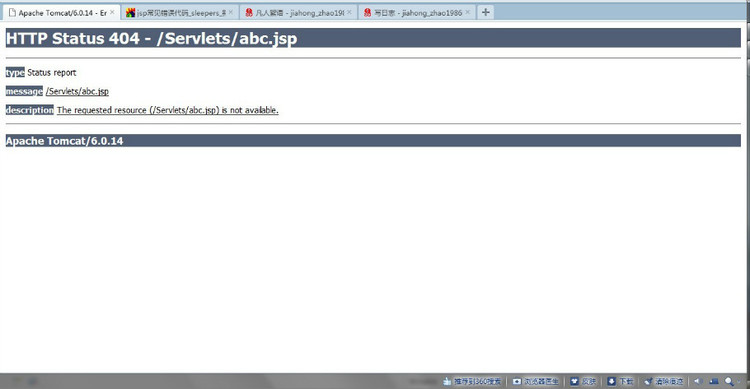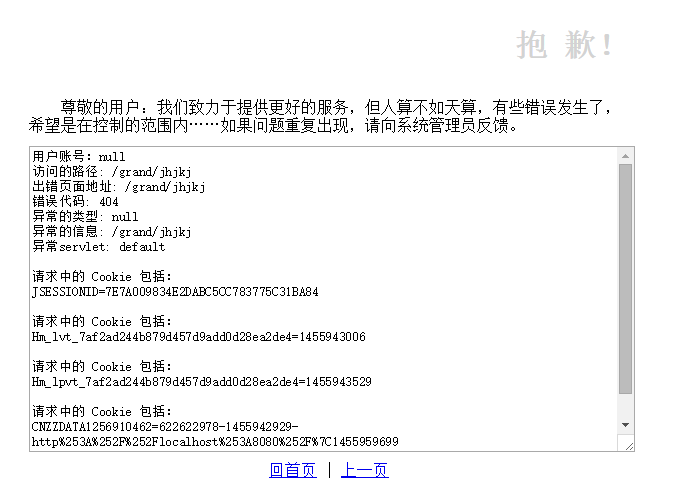Java Web 錯誤/異常處理頁面
阿新 • • 發佈:2019-01-04
------------------------------------------------------------------------------------------------------------------------------------<%@page pageEncoding="UTF-8" isErrorPage="true" import="java.io.*"%> <%!/** * 收集錯誤資訊 輸出到網頁 * * @param request * 請求物件 */ public static OutputStream getError(HttpServletRequest request, Throwable ex) { try( OutputStream os = new ByteArrayOutputStream();// 建立一個空的位元組流,儲存錯誤資訊 PrintStream ps = new PrintStream(os); ){ // 收集錯誤資訊 ps.println("錯誤程式碼: " + request.getAttribute("javax.servlet.error.status_code")); ps.println("異常 Servlet: " + request.getAttribute("javax.servlet.error.servlet_name")); ps.println("出錯頁面地址: " + request.getAttribute("javax.servlet.error.request_uri")); ps.println("訪問的路徑: " + request.getAttribute("javax.servlet.forward.request_uri")); ps.println(); for (String key : request.getParameterMap().keySet()) { ps.println("請求中的 Parameter 包括:"); ps.println(key + "=" + request.getParameter(key)); ps.println(); } for (Cookie cookie : request.getCookies()) { ps.println("請求中的 Cookie 包括:"); ps.println(cookie.getName() + "=" + cookie.getValue()); ps.println(); } // javax.servlet.jspException 等於 JSP 裡面的 exception 物件 if (ex != null) { ps.println("堆疊資訊"); ex.printStackTrace(ps); ps.println(); } return os; } catch (IOException e) { e.printStackTrace(); return null; } } %> <!DOCTYPE html> <html> <head> <meta charset="utf-8" /> <title>錯誤頁面 code:${requestScope['javax.servlet.error.status_code']}</title> <style> body { max-width: 600px; min-width: 320px; margin: 0 auto; padding-top: 2%; } textarea { width: 100%; min-height: 300px; outline:none; border:1px solid gray; padding:1%; } h1 { text-align: right; color: lightgray; } div { margin-top: 1%; } </style> </head> <body> <h1>抱 歉……</h1> <div style="padding:2% 0;text-indent:2em;">尊敬的使用者:我們致力於提供更好的服務,但人算不如天算,有些錯誤發生了,希望是在控制的範圍內。如果問題重複出現,請向系統管理員反饋。</div> <textarea><% out.print(getError(request, exception)); %></textarea> <div align="center"> <a href="${pageContext.request.contextPath}">回首頁</a> | <a href="javascript:history.go(-1);">上一頁</a> </div> </body> </html>
發生伺服器 500 異常,如果預設方式處理,則是將異常捕獲之後跳到 Tomcat 預設的異常頁面,如下圖所示。

不論哪個網站都是一樣的,所以為了滿足自定義的需要,Tomcat 也允許自定義樣式的。也就是在 web.xml 檔案中配置:
<error-page> <error-code>500</error-code> <location>/error.jsp</location> </error-page>
首先說說自帶的邏輯。如果某個 JSP 頁面在執行的過程中出現了錯誤, 那麼 JSP 引擎會自動產生一個異常物件,如果這個 JSP 頁面指定了另一個 JSP 頁面為錯誤處理程式,那麼 JSP 引擎會將這個異常物件放入到 request 物件中,傳到錯誤處理程式中。如果大家有寫 Servlet 的印象,這是和那個轉向模版 JSP 的 javax.servlet.forward.request_uri 一個思路,保留了原請求的路徑而不是 JSP 頁面的那個路徑。在錯誤處理程式裡,因為 page 編譯指令的 isErrorPage 屬性的值被設為 true,那麼 JSP 引擎會自動宣告一個 exception 物件,這個 exception 物件從 request 物件所包含的 HTTP 引數中獲得。
request 物件中包含的異常資訊非常豐富,如下所示:
javax.servlet.error.status_code 型別為Integer 錯誤狀態程式碼 javax.servlet.error.exception_type 型別為Class 異常的型別 javax.servlet.error.message 型別為String 異常的資訊 javax.servlet.error.exception 型別為Throwable 異常類 javax.servlet.error.request_uri 型別為String 異常出現的頁面 javax.servlet.error.servlet_name 型別為String 異常出現的servlet名你可以用 Java 語句 request.getAttribute("javax.servlet.error.status_code") 獲取,也可以在 JSP 頁面中通過 EL 表示式來獲取,如 ${requestScope["javax.servlet.error.status_code"]}。
這個自定義錯誤頁面雖然簡單,JSP 本身也有很好的封裝結果,我也看過別人不少的資源,但細究之下也有不少“學問”,於是我想重新再”磨磨這個輪子“——首先 location 是一個 jsp 頁面,也可以是 servlet,不過萬一 servlet 也有可能啟動不起來的話那就使用簡單的 JSP 頁面就好了。我們通過 JSP 頁面定義內部類的方法,達到頁面與邏輯的分離(無須編寫 servlet)。其餘的思路如下:
- 在 JSP 裡面完成 ErrorHandler 類,另有頁面呼叫這個 ErrorHandler 類
- 不但可以接受 JSP 頁面的錯誤,也可接受 servlet 的控制器傳遞的錯誤,並且提取儘量多資訊
- 全部內容先寫到記憶體,然後分別從兩個輸出流再輸出到頁面和檔案
- 把錯誤資訊輸出到網頁的同時,簡單加幾句話,可以把網頁上的資訊也寫一份到資料庫或者文字
- 可以返回 HTML/JSON/XML
實現程式碼如下:
/**
* 異常處理類
*/
class ErrorHandler {
// 全部內容先寫到記憶體,然後分別從兩個輸出流再輸出到頁面和檔案
private ByteArrayOutputStream byteArrayOutputStream = new ByteArrayOutputStream();
private PrintStream printStream = new PrintStream(byteArrayOutputStream);
/**
* 收集錯誤資訊
* @param request
* @param exception
* @param out
*/
public ErrorHandler(HttpServletRequest request, Throwable exception, JspWriter out) {
setRequest(request);
setException(exception);
if(out != null) {
try {
out.print(byteArrayOutputStream); // 輸出到網頁
} catch (IOException e) {
e.printStackTrace();
}
}
log(request);
if(byteArrayOutputStream != null)
try {
byteArrayOutputStream.close();
} catch (IOException e) {
e.printStackTrace();
}
if(printStream != null) printStream.close();
}
/**
*
* @param request
*/
private void setRequest(HttpServletRequest request) {
printStream.println();
printStream.println("使用者賬號:" + request.getSession().getAttribute("userName"));
printStream.println("訪問的路徑: " + getInfo(request, "javax.servlet.forward.request_uri", String.class));
printStream.println("出錯頁面地址: " + getInfo(request, "javax.servlet.error.request_uri", String.class));
printStream.println("錯誤程式碼: " + getInfo(request, "javax.servlet.error.status_code", int.class));
printStream.println("異常的型別: " + getInfo(request, "javax.servlet.error.exception_type", Class.class));
printStream.println("異常的資訊: " + getInfo(request, "javax.servlet.error.message", String.class));
printStream.println("異常servlet: " + getInfo(request, "javax.servlet.error.servlet_name", String.class));
printStream.println();
// 另外兩個物件
getInfo(request, "javax.servlet.jspException", Throwable.class);
getInfo(request, "javax.servlet.forward.jspException", Throwable.class);
Map<String, String[]> map = request.getParameterMap();
for (String key : map.keySet()) {
printStream.println("請求中的 Parameter 包括:");
printStream.println(key + "=" + request.getParameter(key));
printStream.println();
}
for (Cookie cookie : request.getCookies()){ // cookie.getValue()
printStream.println("請求中的 Cookie 包括:");
printStream.println(cookie.getName() + "=" + cookie.getValue());
printStream.println();
}
}
/**
*
* @param exception
*/
private void setException(Throwable exception) {
if (exception != null) {
printStream.println("異常資訊");
printStream.println(exception.getClass() + " : " + exception.getMessage());
printStream.println();
printStream.println("堆疊資訊");
exception.printStackTrace(printStream);
printStream.println();
}
}
/**
*
* @param request
*/
private void log(HttpServletRequest request) {
File dir = new File(request.getSession().getServletContext().getRealPath("/errorLog"));
if (!dir.exists()) {
dir.mkdir();
}
String timeStamp = new java.text.SimpleDateFormat("yyyyMMddhhmmssS").format(new Date());
File file = new File(dir.getAbsolutePath() + File.separatorChar + "error-" + timeStamp + ".txt");
// try(FileOutputStream fileOutputStream = new FileOutputStream(file);
// PrintStream ps = new PrintStream(fileOutputStream)){// 寫到檔案
// ps.print(byteArrayOutputStream);
// } catch (FileNotFoundException e) {
// e.printStackTrace();
// } catch (IOException e) {
// e.printStackTrace();
// } catch (Exception e){
// e.printStackTrace();
// }
}
/**
*
* @param request
* @param key
* @param type
* @return
*/
@SuppressWarnings("unchecked")
private <T> T getInfo(HttpServletRequest request, String key, Class<T> type){
Object obj = request.getAttribute(key);
return obj == null ? null : (T) obj;
}
} <!-- 404 頁面不存在錯誤 -->
<error-page>
<error-code>404</error-code>
<location>/WEB-INF/jsp/common/default/error.jsp</location>
</error-page>
<!-- // -->
<!-- 500 伺服器內部錯誤 -->
<error-page>
<error-code>500</error-code>
<location>/WEB-INF/jsp/common/default/error.jsp</location>
</error-page>
<!-- // -->
原始碼如下:
<%@page pageEncoding="UTF-8" isErrorPage="true"%>
<%@ include file="/WEB-INF/jsp/common/ClassicJSP/util.jsp"%>
<!DOCTYPE html>
<html>
<head>
<title>錯誤頁面</title>
<style>
body {
max-width: 600px;
min-width: 320px;
margin: 0 auto;
padding-top: 2%;
}
textarea {
width: 100%;
min-height: 300px;
}
h1 {
text-align: right;
color: lightgray;
}
div {
margin-top: 1%;
}
</style>
</head>
<body>
<h1>抱 歉!</h1>
<div style="padding:2% 0;text-indent:2em;">尊敬的使用者:我們致力於提供更好的服務,但人算不如天算,有些錯誤發生了,希望是在控制的範圍內……如果問題重複出現,請向系統管理員反饋。</div>
<textarea><%
new ErrorHandler(request, exception, out);
%></textarea>
<div>
<center>
<a href="${pageContext.request.contextPath}">回首頁</a> | <a href="javascript:history.go(-1);">上一頁</a>
</center>
</div>
</body>
</html>

